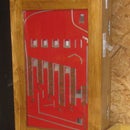Introduction: Camel Racing \ Arabian Derby Arcade Game
I have always liked the camel racing game that is found at the seaside piers or at some carnivals. So I built a version for four people to play.
To see the game in action, see below. Balls landing in yellow hole get 3 points, red 2 points and blue 1 point. Game play takes place on TV screen and as points are accrued the camels move along the screen. The winner is the first camel to 30 points.
Game starts with Bell and Arabian Derby tune.
Supplies
Each play field was build from any old wood I had lying around - chipboard, plywood, OSB, MDF
For each playfield:
Base: 1170x300mm (10mm thick)
Sides:
2 x 1170mm (100mm x 18mm)
2 x 860mm (30mm x 18mm)
Back:
1 x 264mm (100mm x 18mm)
1 x 264mm (30mm x 18mm)
Front
1 x 264mm (30mm x 18mm)
Playfield:12mm MDF (700mmx264mm) & (420mmx264mm)
Acrylic (in my build 540mm x 300mm)
Throwing Cover (300mm x 240mm)
3m CAT5 Cable
3 x SP Lever miniature micro switch
For under the playfield, the widths of wood were cut to 76mm (3") and 64mm (2.5")
4 x 8mm spacers (to raise height of throwing cover)
Controller:
Old keyboard to build keyboard controller - see https://www.instructables.com/id/DIY-Keyboard-Cont...
2 Gang 4 Way CAT5 Socket
45mm Plastic Pattresss Box 2 Gang
Screws, wood glue, paint.
Golf balls for the game. I found 3 balls for each player to be best.
Step 1: Playfield Construction
Each playfield was built to same dimensions.
The base (1170x300mm) was screwed to the two side pieces (100mm x 18mm) and to the back piece (100mm x 18mm). The front piece (30mm x 18mm) was then attached. The two other side pieces were then screwed on.
The pieces 64mm wide were glued into place. A zig zag down the left to slow the ball that scored zero. A channel was made down the right hand side and the two pieces of 18mm x 16mm were attached with space for micro switches. Parallelogram pieces were glued under where the scoring balls would land - these shapes were 18mm thick to be same height as the micro switch track. The pieces 64mm wide were put in place to hold up the upper playfield and the 76mm widths for the lower playfield.
A hole was drilled to take CAT5 cable in back of playfield and tied in a knot to prevent anyone pulling the cable out. The cable was then soldered to the microswitches.
Half way between each micro switch a screw was partially screwed in to the right of the channel. This slowed balls down so they did not speed down over the switches.
The playfield sizes before cutting the V shape were lengths of 700 and 420. 44mm holes were cut with a hole cutter for the balls to fall through. A router was used the curve the edge of the hole.
The lower playfield was fitted, then the upper playfield. A piece of 30mm x 16mm was used to screw down and hold upper playfield in place.
The acrylic was attached. The throwing guard was fitted with 8mm spacers to keep enough clearance for the ball.
The operation of the switches is that when ball goes into blue hole it runs over one switch.
When going into red hole, it goes over a second switch and the switch used by the blue ball.
When going into yellow hole, the ball goes over each of the microswitches,
So each time any of the micro switches is clicked a single point is added to player\camel score.
A couple of pieces of wood were screwed underneath (single screw) where I want the playfield to be supported. This stops the playfield slipping down. A single screw was used so each can slightly rotate for uneven surfaces.
Step 2: Controller Box
An old USB keyboard was used to build a keyboard controller. Instructions on how to do this can be found on https://www.instructables.com/id/DIY-Keyboard-Cont...
The circuit from the keyboard was fitted to a piece of wood that would fit into the 2 gang pattress box. Wiring between controller and each CAT5 outlet was to provide a set of three different keys for each microswitch.
A hole was drilled out the back of the pattress to run USB cable from the keyboard that was used.
To test the controller and playfield, connect playfield to controller and connect controller to PC\laptop. Open notepad and drop a ball in each hole. The relevant letters should appear on the notepad when micro swicthes are hit.
Step 3: Running the Game
The components I have to run the game is
1. Windows laptop to run the software - runs on XP, Windows 7 and Windows 10 without any issues.
2. TV screen with connection from laptop
3. Speakers for laptop (needed when using this outside)
4. Table to hold the playfields. Table needs to be level, preferably slight lean to the right. I use a length of 100mm x 50m timber under the back of the playfields to keep them at the right angle for playing.
5. Connect controller to USB port of laptop
6. Run the ArabianDerby software. I have written this software and am willing to share with anyone who is planning to build same machine or you could write your own version - just needs be based on keyboard inputs when switches are clicked. The software has been uploaded to the Media Fire Repository. I have signed up for free at that site so to access my share you will need to put up with the adverts. The link for the files is found here.
https://www.mediafire.com/folder/xcprqiwcxvxcd/Arabian_Derby











